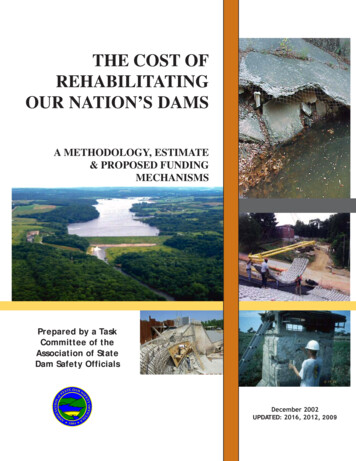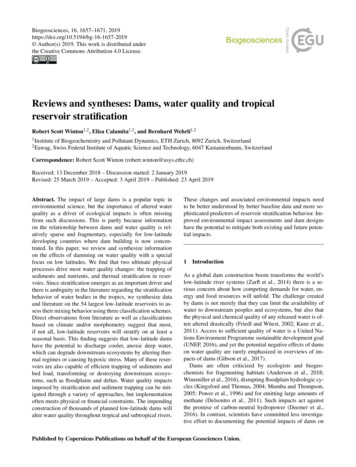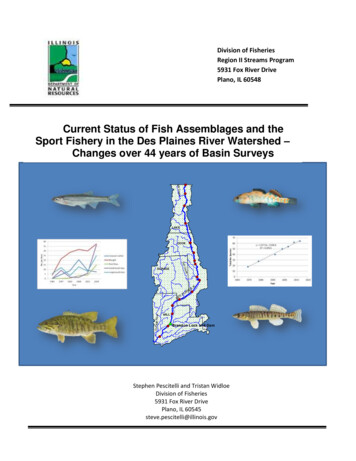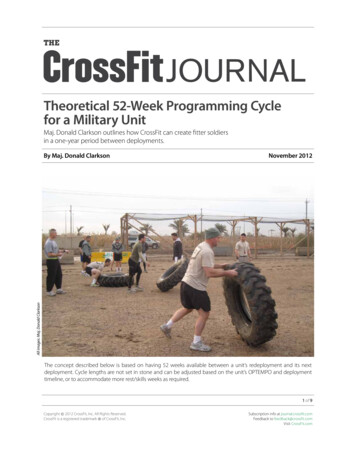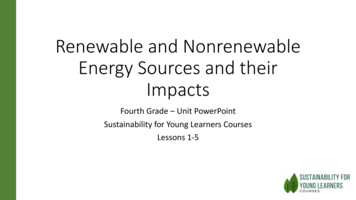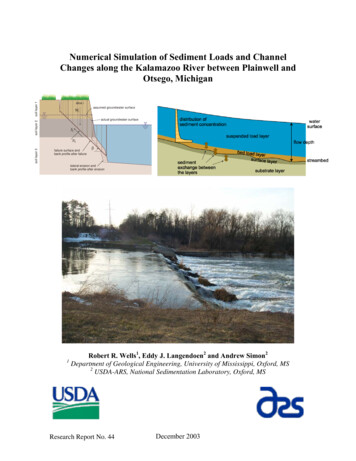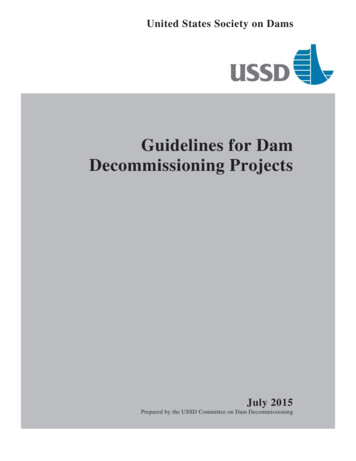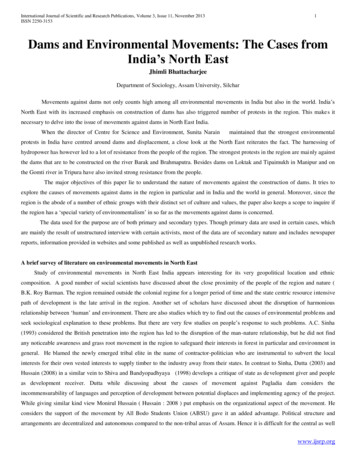
Transcription
International Journal of Scientific and Research Publications, Volume 3, Issue 11, November 2013ISSN 2250-31531Dams and Environmental Movements: The Cases fromIndia’s North EastJhimli BhattacharjeeDepartment of Sociology, Assam University, SilcharMovements against dams not only counts high among all environmental movements in India but also in the world. India’sNorth East with its increased emphasis on construction of dams has also triggered number of protests in the region. This makes itnecessary to delve into the issue of movements against dams in North East India.When the director of Centre for Science and Environment, Sunita Narainmaintained that the strongest environmentalprotests in India have centred around dams and displacement, a close look at the North East reiterates the fact. The harnessing ofhydropower has however led to a lot of resistance from the people of the region. The strongest protests in the region are mainly againstthe dams that are to be constructed on the river Barak and Brahmaputra. Besides dams on Loktak and Tipaimukh in Manipur and onthe Gomti river in Tripura have also invited strong resistance from the people.The major objectives of this paper lie to understand the nature of movements against the construction of dams. It tries toexplore the causes of movements against dams in the region in particular and in India and the world in general. Moreover, since theregion is the abode of a number of ethnic groups with their distinct set of culture and values, the paper also keeps a scope to inquire ifthe region has a ‘special variety of environmentalism’ in so far as the movements against dams is concerned.The data used for the purpose are of both primary and secondary types. Though primary data are used in certain cases, whichare mainly the result of unstructured interview with certain activists, most of the data are of secondary nature and includes newspaperreports, information provided in websites and some published as well as unpublished research works.A brief survey of literature on environmental movements in North EastStudy of environmental movements in North East India appears interesting for its very geopolitical location and ethniccomposition. A good number of social scientists have discussed about the close proximity of the people of the region and nature (B.K. Roy Barman. The region remained outside the colonial regime for a longer period of time and the state centric resource intensivepath of development is the late arrival in the region. Another set of scholars have discussed about the disruption of harmoniousrelationship between ‘human’ and environment. There are also studies which try to find out the causes of environmental problems andseek sociological explanation to these problems. But there are very few studies on people’s response to such problems. A.C. Sinha(1993) considered the British penetration into the region has led to the disruption of the man-nature relationship, but he did not findany noticeable awareness and grass root movement in the region to safeguard their interests in forest in particular and environment ingeneral. He blamed the newly emerged tribal elite in the name of contractor-politician who are instrumental to subvert the localinterests for their own vested interests to supply timber to the industry away from their states. In contrast to Sinha, Dutta (2003) andHussain (2008) in a similar vein to Shiva and Bandyopadhyaya (1998) develops a critique of state as development giver and peopleas development receiver. Dutta while discussing about the causes of movement against Pagladia dam considers theincommensurability of languages and perception of development between potential displaces and implementing agency of the project.While giving similar kind view Monirul Hussain ( Hussain : 2008 ) put emphasis on the organizational aspect of the movement. Heconsiders the support of the movement by All Bodo Students Union (ABSU) gave it an added advantage. Political structure andarrangements are decentralized and autonomous compared to the non-tribal areas of Assam. Hence it is difficult for the central as wellwww.ijsrp.org
International Journal of Scientific and Research Publications, Volume 3, Issue 11, November 2013ISSN 2250-31532as the state government to impose their dictate at will. For Hussain, these political factors also helped the movement to successfullyresist the implementation of the PDP. The focus on differential political arrangement in the region and the role of political factor addsa new dimension to understand the environmentalism of this region. It not only reflects the political factor but also the nature and kindof activism prevailing in the region. North East India being an ethnically sensitive region comprises of people belonging to differentethnic communities who are not only conscious of their ethnic identity but also active in different fronts to preserve their identitywhich led to a different variety of politics and activism in the region. Hence environmentalism may get a ready platform to channeliseits ideology from these platforms.Hydropower generation: A brief lookGenerating hydropower in North East India goes at par with the all India scenario. North East is regarded to have the potentialto be India’s largest Power House. The preliminary ranking study on the nation wide potential of hydroelectric schemes in October2001 conducted by the Central Electricity Authority (CEA), gives Brahmaputra the highest potentiality mark. The ranking studyconsidered 168 schemes which have an installed capacity of 63,328 MW and 149 of these were given A and B ranks, indicating highviability ( Menon et.al : 2003) . In addition to these over 900 mini and micro hydel projects have been identified to meet t he localneeds of the North East while the major portion of the power generated from the large dams will be evacuated to other parts of thecountry.The paper here does not highlight the resistance of people on each and every projects. Few major projects which havegenerated much hue and cry have been considered for analysis out of which lower Subansiri, Tipaimukh and Pagladia counts alongwith some dams of minor range. The strongest protest centres around dams that to be constructed on rivers Barak and Brahmaputra.Besides mention can also be made of dams on Loktak lake in Manipur and on Gumti river in Tripura.As mentioned earlier that Brahmaputra alone has the potentiality and because of it, a number of dams have been constructedon the different tributaries of Brahmaputra. Of its seven states, Arunachal could singly produce most of the megawatts required tofulfill the country’s national policy to generate 50,000 MW by 2012 to provide cheap electricity for the needs of the teeming millionsand the growing economy ( Chhakchhuak : 2006 ). The major projects i.e., mega projects include Subansiri multipurpose dam projectthe proposal of which include three dams namely 1) Upstream of Daporjio near Menga village on Subansiri river 2) On Kamalariver upstream of Tamen 3) Gerukamukh at the original site of Subansiri river. The second the Siang Multipurpose Dam Projectpresently modified into three alternative dams at 1)Upstream of Yingkiong near Pugging village on the river Siang 2 ) at 15 km.upstream of Kaying on the river Siyom near Raying village.3) Upstream of Pasighat near Routung village.The mega projects including the Lower Subansiri (2000) and three projects in the Siang basin have already been handed overto the NHPC for preparation of detailed project reports (DPR). The public hearings have already been held for four projects – thelower Subansiri, the Siang middle project, the Ranganadi Hydro Project State II (RHEP-II) and the Dikrong, now called Pare HydroProject.Besides this, Tipaimukh power project is yet another project that generated enough hue and cry not only at national level butalso at international level. The project to be located in Tipaimukh, at the confluence of Tuivai and Barak rivers adjoining Bangladesh,the project was to harness 1500 megawatt energy at an estimated cost of Rs. 6800 Crores at the recent price level ( DainikYugasankha: 2006 ). The proposed 162,8 m. high rock filled dam aims basically at production of 1, 500 megawatt of hydroelectricity,irrigation of the agricultural fields and prevention of flood in Barak valley of southern Assam and the development of ecotourism, tobe implemented by NEEPCO.Another project that equally needs mention is the Pagladia dam project. It was originally conceived in 1968-67 as a minorflood detection project at an estimated cost of Rs.12.60 crores. In 1984-85, the project was taken over by the Brahmaputra Board.www.ijsrp.org
International Journal of Scientific and Research Publications, Volume 3, Issue 11, November 2013ISSN 2250-31533Later, the irrigation aspect was added to the project costing 287.86 crores at 1988-89 price level. The project gradually took the formof multipurpose project with the goal of irrigation, flood detection and generation of electricity. The major target was protection of40,000 hectares of land in Nalbari district, irrigation of 54,160 hectares of land spread over 145 villages of the district and to generate3 megawatt electricity. A detailed report of the project in compliance with the observations of the technical advisory committee reportof the Ministry of Water Resources was submitted in November 1992. This paved the way for the techno economic clearance of themulti purpose project. In 1995, the project received clearance from the Ministry of Environment and Forests and after updating thecost estimate of the project to 540.99 crores at 1999 price level, the Public Investment Board of the Government of India accorded itsapproval at the cost of 526.62 crores in March 2000.Why protests?North East India interestingly registers its strongest environmental movement centring the construction of dams. Though theprojects are at different stages of development, some commonalities are observed in all cases. A clear observation is the social,economic, cultural and environmental impact of these dams on the affected people living in downstream areas. In most of the cases theexperiences of the people with the project seems to create a crisis of confidence in the government particularly its department ofenvironment and forests. The activists allege that the project clearance in the stages of site selection, making Preliminary FeasibilityReport (PFR), Detailed Project Report (DPR), Environmental Impact Assessment (EIA), public hearings into stage managed affairswhere people’s voices were not allowed to emerge, ignored or cleverly manipulated to suit the project.While taking lower Subansiri project under consideration, it is found that the 116 m. high dam would submerge 3,436 ha.offorests. The total requirement of forest land for the project is in Arunachal Pradesh and 856.3 ha. In Assam survey and investigationworks have been completed and the Detailed Project Report (DPR) is presently undergoing the techno-economic clearance requiredfrom the MoEF.The submergence area of the lower Subansiri dam will extend over 70 km. upstream along some of its tributaries such as theKamala and the Sil. Since the submergence area is a gorge with steep slopes and rugged topography, relatively few villages will bedirectly displaced. According to the project authorities the dam will submerge the agricultural lands of two villages, Gengi andSiberite. The families to be affected belong to the Gallong tribe, a subgroup of the Adis. These are agricultural communities practicingjhum cultivation, terrace rice cultivation and wet rice cultivation near the river bed. Besides they also depend on forest for theirlivelihood. So, all these resources will no longer be available once they are displaced. According to the EIA report prepared byWAPCOS, New Delhi, for NHPC, the project affected people (PAP) will be offered housing and homestead land, cultivable land (onehectare), civic amenities, schools and vocational training in animal husbandry, horticulture, weaving and other activities. It has beenseen that the Resettlement and Rehabilitation plan spelt out for the PAFs 38 hactares of cultivable land (one hectare for each family)and 200 sq. km. of homestead land for each family will be given as compensation for a total 960.11 hactares of land.A major reaction and opposition from peoples’ organization and environmental experts in the region came up because of theprojects’ failure to adhere to the legal processes created to safeguard public interest. Neeraj Vogolikar, an environmental activist andclosely associated with the problems of environment in the North East maintained that MoEF has ignored the plea of the severalorganizations to the ministry for looking at the serious problems in the clearance process of the Lower Subansiri Hydroelectric Projectand granting the clearance for the projects.Like Subansiri, Tipaimukh hydroelectric project also has been the bone of contention between the government and theaffected people. The project is anticipated to submerge 275.50 sq. km of land surface in the state and to affect 191 sq.km ( Dainikwww.ijsrp.org
International Journal of Scientific and Research Publications, Volume 3, Issue 11, November 2013ISSN 2250-31534Yugasankha : December 13, 2006) .1 The dam is also anticipated to doom all the potentialities of the Barak catchment area. Theproject will submerge the national highway no. 53, the only alternative to Imphal Dimapur lifeline (NH No.39). Hence new alignmentof the submergible points on the road will add a distance of another 60 kms to the existing Imphal-Jiribam-Silchar road. ThoughManipur and Mizoram have been promised 12 percent of the output as royalty, the critics have long been warning that the dangers faroutnumber the potential benefits. For instance, the Naga leaders claimed that the dam would submerge the socially and economicallyimportant places. The site chosen for the dam on the Tuivai river was also prone to intense seismic activity. The dam will alsosubmerge various historical and legendary sites and sacred groves with vital spiritual and cultural significance to the communities andlead to destruction of rich biodiversity which is threatening the peoples’ right to life and livelihood. Like other development projectsin the north east, here too, the people that are most adversely affected are tribes: the Zeliangrong a constituent of three Naga tribes andthe Hmar will be the direct victims of the project.The dam also encountered opposition from the very day of the proposal for its adverse impact on ‘Man and Environment.’ Theaffected people had demanded that the project should not be taken ahead till the public scrutiny of the project is not accomplished.There is also demand that the project should follow the WCD guideline as it is going to affect the neighbouring countries. Thus thisproject also shows a ‘crisis of confidence’ on government by the affected people. Environmental groups alleged that the NEEPCOauthorities have been ignoring the demand of the people to supply them with details of the environment study report despite thestatutory provisions for supply of such reports to the people. They also alleged that the authorities concerned have paid no attention tothe demand for holding public hearings in Manipur and Assam, which will also be affected by the project. Also, compliance with theinternational norms for consulting the riparian countries in case the river in question is an international one is also ignored by theauthorities concerned in this case.The crisis of confidence thus emerges centring different issues relating to social, cultural, economic and environmental impactassessment by the government on project affected people. If in one side there is a fear of loosing the homestead, on the other side it isthe fear of loosing the cultural heritage. Along with these, the knowledge of the people about the fate of affected people of dams likeGumti, Koptai etc. also have created further crisis in affected people’s mind.The instance of Pagladia dam project highlights the problem in further detail. The project also registers major hue and cry fromthe affected people of the dam built on the river Pagladia. According to the project plan, a 23 kilometers long and 26 meters high damwill be constructed along with a reservoir to retain 446 million cubic meters of water. The main canal would be 66.2kms long and abranch canal of 39.5 kilometers making it 105.7 kilometers in total.Altogether, 38 villages would be submerged under the proposed project. In January 2003, the government issued notificationfor the acquisition of land from the villagers. Mention may be made that all the villages expected to be submerged fall under theproposed Bodoland Territorial Council (BTC) area. While the Brahmaputra Board, the implementing agency of the dam projectclaimed that only 20 percent of the potential displacees belonged to the Scheduled Tribes, according to the affected people the figureis around 90 percent. According to its estimation the Board has drawn up a Resettlement and Rehabilitation (R&R) package at the costof Rs .47.89 crores, aiming to rehabilitate 18 ,473 people and 3, 271 families. However, in the opinion of the affected people, thegovernment figure was extremely low and the actual figure comes to around 50,000 people belonging to 5,000 families. Moreover thefigure did not include the number of potential displaces of the five villages newly added to the original 33 affected villages pointed outby the dam resistance committee that had launched a long struggle against the construction of the dam and the Brahmaputra Board.While the government claimed that it would compensate all the affected people of the dam project, by providing handsome Rand R package, the people were not convinced. The villagers had their own view of the fate of the dam displaces based on theirwww.ijsrp.org
International Journal of Scientific and Research Publications, Volume 3, Issue 11, November 2013ISSN 2250-31535assessment of the affected people of similar projects as has been mentioned in an article published in the souvenir of the PDPKASS.The people of the projects who have not been given rehabilitation and some of the projects which have not been completed arementioned in the article as affected people of Borlia river, Suklai, Champanadi, military base at Satgaon in Guwahati, Jagiroad papermill, capital complex at Dispur, NEEPCO Duliajan Project at Kathalguri, Dinjan Military Base and Numaligarh Refinery project(K.N. Bodo : 2000 ). The people were also aware of the fate of other projects, such as, Bhakranangal projects learnt from theinteraction they had with the dam activists. Hence people felt that both the state government and Union Ministry of Water Resourceshave simply been fooling the people of Nalbari who were going to be affected by the project. Besides more than 40, 000 people wereexpected to be affected by the project, the government proposed to acquire another 34, 000 acres of land, which is very fertile. Thoughthe project was going to affect different communities such as Rabha, Rajbanshi, Nepalese, Bengalis, Santhals etc, the Bodos weredemographically the largest groups to be affected in the area, most of whom were peasants. Hence acquisition of land from them wasthus the acquisition of livelihood of these victims. In addition to this, the proposed project would submerge four high schools and fortyprimary schools, several primary health centres, temples, Namghars and other places of worship.While the rehabilitation of the social and cultural assets of these victims would be practically impossible to achieve, theeconomic rehabilitation was yet another hidden difficulty observed by the villagers. Though the Brahmaputra Board has prepared aseparate R and R package for the displacees, only 47.89 crores had been allocated for the same. Moreover the potential displaceeshave lost faith in the state government and the claim of the Brahmaputra Board. Moreover the land selected by the government ofAssam for the rehabilitation of the displacees were already occupied by thousands of refugees from East Pakisthan (presentBangladesh), the Nalbari district does not have sufficient land at its disposal to accommodate the displaced population. Thus thepeople are aware that the government would not be in a position to rehabilitate peasants with due grant of fertile land in the newlysettled area. Hence they are to be settled in hill reserved forests which will not only lead to forest loss but also once again bring athreat to the livelihood of the people. Besides, the district being densely populated, it can not accommodate the entire gamut ofpopulation in the same area which would lead to ethnic dispersion and loss of traditional kinship and ethnic ties. The lack of absoluteownership over land by many of the inhabitants of the affected area has created another feeling of scarcity in the minds of the victims.They feared that like in many other cases of developmental projects, the people who did not possess proper land documents will not beable to avail the R and R measures. All these cummulutive feelings of the villagers have led them to refuse and reject each step by theBrahmaputra board and the government of Assam to implement the plan to construct a dam on the Pagladia river.The situation has been better analysed by the noted social scientist from the region as the situation of contestation between stateas development giver and people as development receiver which is continuing for four decades with a periodic lull. The protest of thepeople against the dam thus clearly reflects the unease of the people who are affected by the project, shows the penetration of the statein the lifeworld of the people who are affected by the project creating a legitimacy crisis or a crisis of confidence. Dutta here evenquestions the inter linkage between development and democracy. He highlights the incommensurability of languages and perceptionof development between the potential displaces and Brahmaputra Board of Assam. For him, the affected people find the project asillegimate and undemocratic, what he considers as marginalization of democratic right of the people.The moveThe construction of dams in the region have met with opposition from the very inceptions. Different organizations emergedat different periods of time to register their protests. The organizations that strongly opposed the lower Subansiri dam project areArunachal Citizens’ Rights ( ACR), Dam Displaced People ( DAP) , Probable Project Affected Peoples Committee (PPAP),Downstream Peoples’ Committee ( DPC), Proposed Project Land Affected Peoples’ Forum, Yazali ( PPLAPFY), Subansiri BachaoCommittee, Siang Valley Bachao Andolan etc. Citing the example of the impact of Koptai dam in Bangladesh which has displacedwww.ijsrp.org
International Journal of Scientific and Research Publications, Volume 3, Issue 11, November 2013ISSN 2250-31536thousands of Chakma to this region the Chairman of the ACR says, “We don’t need to go anywhere to see this; we have an exampleright here. Rehabilitation, no matter how good the intention, is just not possible.”2Tweenty NGOs and voluntary organizations based in North East have come together under the banner of the North EastDialogue Forum to register a combined protest against the building of large dams in the region ( The Assam Tribune : 2006 ). 3 Theoffice bearers maintained that apart from the displacement of huge sections of people and infringement of land ownership rights , theproposed dam will also have a negative impact on the downstream residents of Assam, effect on whom had not been studied indetail. K.K.Chandradhara, Secretary of the Peoples’ Movement for Subansiri-Brahmaputra Valley (PMSBV), who was also presentduring the media briefing insisted that this flouting of rules and norms has been brought to the notice of the Union Ministry ofEnvironment and Forests by the activists of PMSBV which has been at the forefront of the opposition to the project since its inception.The case for the construction of mini hydel projects in place of big dams to meet the power short fall in the country have also beenstressed .The Tipaimukh dam has encountered opposition from the very day of the proposal. There has been pronounced campaignagainst the project for its adverse impact on environment. A committee named Commitee against Tipaimukh Dam, which constitutedvarious people’s organizations was formed to create mass awareness on the negative impacts of big dams and mobilize publicopinions for resisting the controversial Tipaimukh High Dam. But the Union Power Ministry has continued to pursue the constructionof the dam despite the continued protest from the project affected people. 4 Various representatives from the Committee AgainstTipaimukh Dam (CATD), NWUM ( Naga Women’s Union, Manipur), NPMHR (Naga People’s Movement for Human Right), UNC(United Naga Council), ANSAM (All Naga Student’s Association, Manipur )including the ZU ( Zeliangrong Union), ZWU(Zeliangrong Women’s Union), ZSUM (Zeliangrong Students Union, Manipur), ZYF (Zeliangrong Youth Front ) called on theGovernor and the Chief Minister of Manipur to apprise them about the feelings and stand of the people regarding the construction ofthe Tipaimukh dam. In reply, the Governor said all have the constitutional rights to preserve their cultural identity. He said that heknows Barak waterfall and Zelliad lake are the cultural heritage of Manipur. Similarly, the Chief Minister O. Ibobi Singh whilelistening to the people’s concern shared that a project of such magnitude should very much have wide consultation with the peoplewho are to be adversely affected by the dam. But all opinions and commitments could hardly bring any reflection in the activities asthe Dam Action Committee was very often brought the fact of lack of accountability of the Manipur Government in the preparation ofdifferent reports on the fate of the dam and its impact on people.Five Naga organizations of Manipur: UNC, NWUM, CATD, NPMHR, ANSAM in another move have petitioned the centreto shelve the Tipaimukh Dam, citing threats to the existence of 18 Zeliangrong Naga inhabited villages and several sites held sacredby the community. The organizations in a memorandum to Union Power Minister strongly stated that the dam was not conceived withthe interests of the tribal people in mind. They also threatened the Manipur government that they would go in for more stringent actionif the government failed to shelve the project.The organizations also demanded that the Nagas should not be denied the right to information on environmental assessmentand for participation in any development project that affect their livelihood and dignity. The dams can not be allowed to beconstructed if it is inevitably going to destroy one section of society. Besides the Citizens Concern for Dams and Development(CCDD) have demanded that till informed public scrutiny of the project is not accomplished, the project should not be taken ahead.CCDD also demanded that the project should follow WCD guideline 5.2345Ibid3, August, 2006, The Assam TribuneSANDRP, 2003.Dams, Rivers and People update, SANDRP, February, 2003www.ijsrp.org
International Journal of Scientific and Research Publications, Volume 3, Issue 11, November 2013ISSN 2250-31537On January 4, 2005, altogether 17 organisations from the country and abroad have objected to the then Union Minister ofstate for Industries and Public enterprises Santosh Mohan Dev who convened a meeting of the Chief Secretaries of the three states ofManipur, Assam and Mizoram at New Delhi for discussions on the project. The indigenous people spearheaded the people’smovement in these two states argueing that the proper documents relating to the assessment study were not supplied to the people byNEEPCO authorities.The public meeting on the assessment report called by the Mizoram Pollution Control Board on December 2, 2004, had to bepostponed following wide spread public protest. In a communiqué to the authorities concerning the dam, on January 9, CCDD said“any decision on the Tipaimukh power project should not be taken without the prior and informed consent of the people of Manipur.An independent accountable and participatory Environmental Impact Assessment must be undertaken involving full participation ofpeople of Manipur.” CCDD also maintained that there are no concrete plans for resettlement and rehabilitation of the people who willbe displaced by the project. It also added that no environment management plan, risk management plan or cost benefit analysis havebeen conducted.The opposition to the Pagladia dam began from a period between 1968 and 1971, when investigation was conducted by thestate for the construction of a minor flood detention project. To combat the government’s attempt to construct the dam the educatedpeople of the effected area formed a committee called “Pagladia Dam Protection Committee”. Late Sri Mukundaram Medhi was thefounder president of the committee and late Bitty Barman was the Secretary.Soon after its inception, the activists of the protection committee went to Shillong, the then capital of Assam and demandedthe immediate closure of the project by the Assam Legislative Assembly. Due to the relentless opposition by the people, theGovernment had to close the project. But the AGP Government tried to re-open the file of Pagladia dam project and restart the projectby investing Rs.500 crores in order to solve the problem of perennial flood in the region.After this declaration the disappointed people of the effected area formed another committee called Pagladia BandhPrakolper Khatigrastha Alakar Sangram Somittee [PD PKASS] to counter what they consider to be an onesided undemocraticdecision. Adopting a non violent and democratic strategy, this committee opened a new ch
North East with its increased emphasis on construction of dams has also triggered number of protests in the region. This makes it necessary to delve into the issue of movements against dams in North East India. When the director of Centre for Science and Environment, Sunita Narain maintained that the strongest environmental



